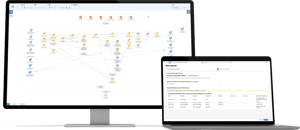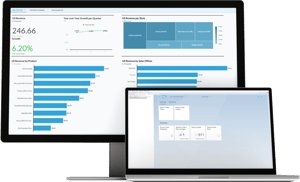SUSTAINABILITY
REPORTING
Companies are increasingly required to implement a sustainability reporting solution that meets both internal and external requirements. SAP, as the market leader in this area, offers companies the necessary support to meet these increasing requirements. CALEO is at your side to successfully implement these solutions in practice.
SAP solutions for the new ESRS standard: Sustainable reporting and strategic growth.


Sustainability pays off.
Dr. Theodor Weimer
(Chairman of the Executive Board of Deutsche Börse AG) in 4.Zero
(Spokesman of the Executive Board SAP SE) in 4.Zero
processes and to develop new, innovative measurement, control and risk minimization instruments [...]"
Sustainability reporting with SAP
ESG reporting is critical in today's business world, and SAP offers companies two efficient ways to achieve this goal. On the one hand, companies can use the SAP Sustainability Control Tower, a stand-alone solution from SAP that serves as a "one-stop store" for all sustainability requirements. Secondly, it is possible to expand an existing reporting landscape based on SAP BW/4 or Datasphere as part of an individual development. This approach offers companies full flexibility to adapt their reporting to their specific business requirements. Regardless of the method chosen, CALEO is ready to support you in implementing the right solutions for you. With our expertise and experience, we can ensure that your sustainability reporting is successfully implemented.
SAP Sustainability Control Tower
- One stop store for sustainability reporting
- Less preparatory work thanks to a preconfigured solution
- Alignment with current reporting standards
- Full integration into the SAP Business Technology Platform
- Simplified operation thanks to ready-made content
- Integrates frontend and backend in one solution
- Audit trail for auditors

SAP BW/4 or Datasphere
- Full flexibility
- Integration of ESG data into existing reporting on a standardized platform.
- Simple connection of external SAP and non-SAP systems
- Integration of operational data through integration of external systems
- Optimization opportunities through impact analyses of operational processes on financial performance.
- Use of various reporting front-ends (Analysis for Office, SAP Analytics Cloud, ...)

We support you in setting up your ESG reporting!
At CALEO, we combine a deep understanding of financial processes with specialized SAP know-how to optimally set up your ESG reporting. Our holistic consulting services range from requirements analysis to training your team. With a diverse team of business economists, IT specialists and other experts, we rely on specialist knowledge rather than team size to make your financial projects a success. Each of our consultants is also a certified SAP consultant, which underlines our high quality standards.
The bottom-up process. In 6 steps to implementation.
Energy consumption is measured automatically (e.g. digital electricity meters) and there is a local system for storing consumption data.
Meter readings that are not recorded automatically can be measured manually at regular intervals (e.g. daily or weekly) and recorded digitally (the longer the interval, the less accurate the final result).
Order data (at least start/end, quantity OK and quantity nOK) are recorded.
A BW/4 is available in the company.
Database-based systems can be integrated virtually with HANA Smart Data Access or as data replication with HANA Smart Data Integration.
The decision for virtual or physical data storage essentially depends on the amount of data and the process requirements (auditability).
If the data is available in the HANA database, it can be made available in a BW/4HANA data model.
Up to this point, the data is usually transferred 1:1.
The data model merges the order data with the energy data so that the energy consumption per order or per part produced is calculated.
The results are combined with external information such as theCO2 equivalent of a kWh of electricity (electricity mix) and theCO2 content of a kWh of gas and converted intoCO2 emissions per part.
The transformations can either replicate the data or provide virtually transformed data from the upstream systems.
If the data was previously passed on virtually, replication is recommended here in order not to slow down reporting.
Based on the data model, a report can be created to answer the initial question, showingCO2 emissions by product.
In addition, this data enables the creation of reports on energy efficiency and production performance, which help to identify potential.
The top-down process with BW/4HANA. In 6 steps to implementation.
Energy consumption is measured at least over a representative period at workstation level (this is usually done anyway).
Periodic data on turnover, scrap costs and changes in inventory value as well as price calculation (production costs) and sales prices (average) are available in the ERP.
The data can be accessed via extractors (SAP) or via HANA Smart Data Access (non-SAP).
Data from SAP ERP systems can be integrated directly into BW as a data source via the extractors.
If the data from non-SAP systems is available in the HANA database, it can be made available in a BW/4 data model.
Weights for the individual products are developed from the representative energy measurements and loaded into BW.
Using the weights (equivalence figures) and quantities, the total CO2 emissions are allocated to the individual products.
The CO2 emissions of the scrap can then be allocated to the good parts.
Savings measures can be derived from the short-term measurements carried out.
In focus
Neuer Validierungsprozess mit SAP S/4HANA
SAP S/4HANA Cloud Public Edition 2502
Offizielle Statistiken im Reporting
FAQ ESG Reporting
As there are many questions surrounding this complex topic, we have compiled a FAQ on ESG reporting. Here you will find answers to frequently asked questions to help you better understand the basics of ESG reporting.
The EU Taxonomy Regulation sets out clear, generally applicable rules and framework conditions for when an economic activity can be classified as sustainable or environmentally friendly.
The regulation refers to the EU's 6 environmental objectives:
- Climate change mitigation
- Adaptation to climate change
- Sustainable deployment and use of water or marine resources
- Transition to a circular economy
- Prevention or control of pollution
- Protection and restoration of biodiversity and ecosystems
The "Sustainable" classification is based on four criteria:
- The activity contributes to at least one of the environmental objectives
- The activity does no significant harm to any of the environmental objectives (does no significant harm DNSH)
- The activity meets minimum safety standards to avoid a negative social impact
- The activity fulfills the technical criteria developed by the EU Technical Expert Group
The EU taxonomy became known in the media through the discussion as to whether or not natural gas technologies or nuclear power are sustainable in this sense.
Financial companies and large companies (>500 employees), which fall under non-financial reporting, are currently affected. The EU taxonomy-compliant shares of turnover, capital expenditure (CapEx) and operating expenses (OpEx) are reported. An expansion of the group of companies affected is being planned. In the medium term, almost all companies will probably be affected.
Essentially, the EU taxonomy regulates reporting obligations for environmentally relevant financial indicators. General environmental aspects (e.g. CO2 emissions), social aspects and aspects of corporate governance are regulated in other regulations and laws.
The focus of discussions in the area of ESG reporting is usually on the reduction of greenhouse gases (especially CO2). In this
context, we often read about the three "scopes" of greenhouse gas emissions. They divide the emissions generated by a product
emissions generated by a product into three categories:
Direct scope 1 greenhouse gas emissions are generated directly by the process, for example in the chemical industry during various reactions. However, emissions from coal-fired power generation also belong to Scope 1 for a power plant operator.
Indirect Scope 2 greenhouse gas emissions are caused by the use of energy in the form of electricity or heat. The current energy mix, for example, currently pollutes the atmosphere with just under 500g of CO2 per kWh.
Scope 1 and 2 represent the proportion of the CO2 footprint of a product that can be directly influenced by producers. By optimizing the product and processes and by procuring sustainable energy or generating their own energy, producers have a corresponding lever here.
Scope 3 represents the greatest challenge for companies in terms of data procurement. There are two categories here:
Scope 3 - Upstream includes all emissions caused by a product through the production and transportation of raw materials. Here, companies should consider the entire supply chain.
Scope 3 - Downstream includes all emissions caused by a product after it leaves the company. This includes emissions for operation (e.g. car exhaust fumes) or emissions for disposal or recycling.
The International Sustainability Standards Board (ISSB) is a body set up by the International Financial Reporting Standards (IFRS) Foundation. Its task is to develop uniform global standards for reporting on sustainability aspects in companies. The ISSB aims to ensure that companies provide clear and comparable information on environmental, social and governance issues in order to provide investors and other stakeholders with better insights into sustainability performance.
Shall we get to know each other?
Are you interested in a non-binding virtual meeting over a cup of coffee? Let's have a relaxed chat and find out how we can work together successfully.
